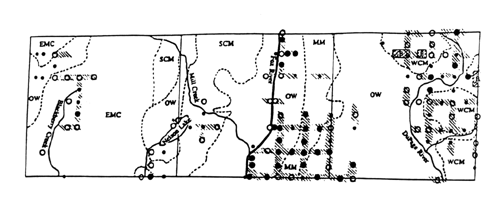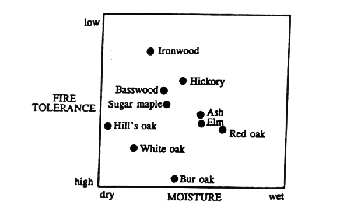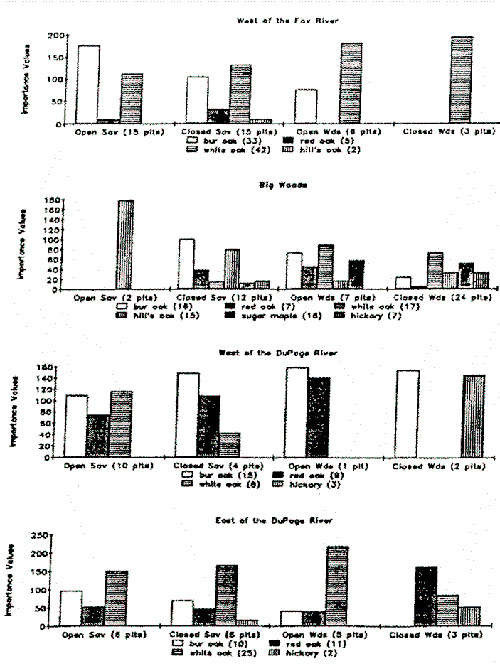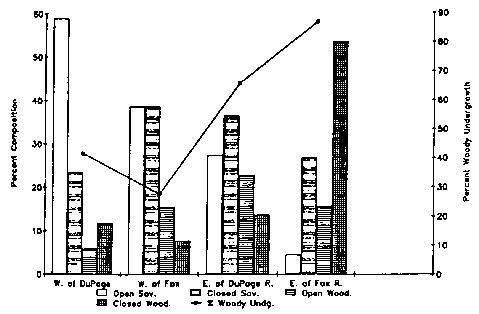
| Great Lakes Ecosystems | ||

|
|
|||||||||
|
1994
Proceedings
|
LANDSCAPE PATTERN AND STRUCTURE OF OAK SAVANNA, WOODLAND, AND BARRENS IN NORTHEASTERN ILLINOIS AT THE TIME OF EUROPEAN SETTLEMENTMarlin L. Bowles Max D.
Hutchison |
 |
At the time of European settlement, the northern border of the prairie peninsula was a broad mosaic of prairie and oak-dominated savanna and woodland (Curtis 1959; Davis 1977; Anderson 1983). This pattern was primarily climatically induced and controlled by fire, with timber persisting on the lee side of firebreaks such as topographic features and water courses (Gleason 1913; Moran 1978, 1980; Anderson 1991; Leitner et al. 1991). The pattern shifted with changing climatic conditions (Grimm 1983, 1984). Because of wide-scale deterioration from fragmentation, fire suppression, and overgrazing, this vegetation remains poorly understood and difficult to classify (Apfelbaum & Haney 1991; Faber-Langendoen in press) but has high conservation and restoration priorities (e.g., Burger et al. 1991; Stearns in press).
Due to the lack of information or supportive data on savanna, woodland, or barrens, managers and restorationists often rely on historical descriptions and assumed ecological relationships. For example, presettlement burning often is assumed to have maintained a savanna-woodland continuum with a graminoid fuel matrix that was free of woody understory vegetation (e.g., Apfelbaum and Haney 1991; Wilhelm 1991; Packard 1991, 1993). Woody understory vegetation structure is rarely discussed in this context; it is often removed by managers and seldom restored. However, this has come under debate in the Chicago region of Illinois (Mendelson et al. 1992; Whelan & Dilger 1992; Packard 1993). Thus, as more oak savanna and woodland recovery efforts are initiated, the fates of their woody understories become the focal point of management decisions.
Studies of the Government Public Land Survey (PLS) witness tree data (Moran 1978, 1980; Rodgers and Anderson 1979; Leitner et al. 1991) have used arbitrary tree density classes to map savanna and woodland in relation to landscape features. However, these studies have rarely provided information on the presence and structure of woody understory vegetation, which appears critical to understanding and guiding management and restoration of oak savanna and oak woodlands. In this paper we examine effects of different landscape features on savanna and woodland patterns and structure at the time of settlement. Research questions were: 1) how well do landscape firebreak features correlate with patterns of prairie, savanna, and woodland, 2) to what degree do these features affect woody species structure and composition of savanna and woodland, and 3) can this information be used to help manage and restore native oak communities?
We analyzed the ca. 1840 PLS data from Batavia, Blackberry, and Winfield townships in Kane and DuPage counties of northeastern Illinois. Surficial stratigraphy includes alternating glacial moraines and outwash crossed by drainages (Fig.1). From west to east, these features include the Elburn Moraine, which is drained by Blackberry Creek, the St. Charles Moraine, which is drained by Mill Creek and Nelson Lake, the Fox River, the Minooka Moraine, and the West Chicago Moraine, which is crossed by the DuPage River. Maximum relief between outwash and moraines is about 50 feet east of the Fox River and over 100 feet west of the Fox River. The PLS indicated timber in four areas, the largest of which was the "Big Woods" east of the Fox River (Fig. 1).
PLS notes for the study area provided the identity, diameter, distance, and direction of two to four witness or line trees at quarter-mile intervals along a grid of 1-mile section lines. We summarized presence and species of woody undergrowth along section lines. Using the modified quarter method of Cottam and Curtis (1956), we calculated the relative density, basal area and importance value (sum of relative density + relative basal area) by tree species for each of four categories: open savanna (<1-10 trees/ha), closed savanna (>10-50 trees/ha), open woodland (>50-100 trees/ha) and closed woodland (>100 trees/ha). We then used frequency analysis to determine the abundance of woody vegetation types recorded in section line summaries. This allowed us to map and analyze woody vegetation and structure patterns present at the time of settlement.
To determine the effects of landscape features on fire and vegetation, we compared vegetation structure among wooded areas afforded different levels of fire protection. These comparisons included woodland west of the Fox River, the Big Woods east of the Fox River, and woodland west and east of the DuPage River on the West Chicago Moraine. We also ordinated (McCune 1993) all section corner witness trees and quarter-mile section line trees to determine if moisture and fire gradients (sensu. Grimm 1984) could be related to species distributions.
Open savanna occupied 27%, closed savanna 32%, open woodland 15% and closed woodland 26% of the wooded landscape. Tracts west of the Fox River were 77% savanna, occupied <25% of the overall landscape, and were closely associated with Blackberry Creek and the Nelson Lake drainage (Fig. 1). Surprisingly, few trees occurred north of Mill Creek, which crosses the St. Charles Moraine from northwest to southeast. Six tree species occurred west of the Fox River where bur oak (Quercus macrocarpa) and white oak (Q. alba) comprised 81% of all tree species. Timber occupied >50% of the total landscape east of the Fox River. Twelve tree species occurred in the Big Woods which was 31% savanna. Here, bur oak and white oak comprised only 33% of all species. Other dominant species included Hill's oak (Q. ellipsoidalis), red oak (Q. rubra), sugar maple (Acer saccharum), and hickory (Carya sp.). On the West Chicago Moraine, savanna comprised 82% and 64% of the timber west and east of the DuPage River, respectively. Bur, red, and white oak and hickory occurred on the West Chicago Moraine with bur oak and white oak sharing dominance. Barrens, from which witness trees were not usually recorded, also occurred on the West Chicago Moraine (Fig. 1). The ordination patterns suggest that tree species occurred along fire tolerance and moisture gradients (Fig. 2; Grimm 1984).
There were no apparent differences in tree size between timbered tracts. Mean tree diameter was 17.6 cm west of the Fox River, 15.6 cm in the Big Woods, and 14.4 cm on the West Chicago Moraine. However, tree density was much higher in the Big Woods, with 211.6 trees/ha compared to 53.8 trees/ha west of the Fox River and 75.3 trees/ha on the West Chicago Moraine.
Substantial differences in importance values of different tree species occurred across gradients of tree density, which are probably related to gradients of fire frequency or intensity (Fig. 3). West of the Fox River, bur oak was dominant in open savanna and shared dominance with white oak in closed savanna, while white oak was dominant in open and closed woodland. In the Big Woods, Hill's oak was dominant in open savanna and shared dominance with bur oak in closed savanna. These species were replaced by red oak, white oak, and sugar maple in woodland. Presence of the DuPage River affected tree dominance and distribution on the West Chicago Moraine. Bur oak and red oak were most important west of the DuPage River, while white oak was most important east of the river.
Wooded tracts throughout the study area were characterized by the PLS as either "timber with undergrowth" or "timber without undergrowth." At least 14 woody species were recorded as undergrowth, but hazel (Corylus americana) was the only important species, occurring in ~80% of all 1-mile sample transects with undergrowth (Fig. 4). This undergrowth was most strongly associated with the east flanks of rivers. It was infrequent west of the Fox River, but occurred on about 90% of the section lines in the Big Woods. On the West Chicago Moraine, frequency of undergrowth was 42% and 66% west and east of the DuPage River, respectively.
As in other areas of the prairie/forest transition, landscape firebreaks clearly controlled the position of prairie, savanna, and woodland on the presettlement landscape in northeastern Illinois (Fig 5). These communities were probably spatially and temporally dynamic with landscape processes such as drought enhanced growing season fires a primary factor in the structure and condition of woody understory vegetation (Anderson 1982). In general, prairies developed on level outwash or ground morianes, woodland persisted on the east flanks of well-defined firebreaks, and savanna developed in areas of intermediate fire protection (Gleason 1913; Moran 1978, 1980; Anderson 1991). In Batavia, Blackberry, and Winfield townships, open savanna and open woodland were less frequent than closed savanna and woodland. Watercourses and topographic relief interacted as firebreaks, with tree density and fire intolerant tree species increasing with increasing fire protection. The largest stream, the Fox River, was the most effective firebreak, allowing persistence of fire-intolerant species such as sugar maple. In contrast, bur oak, a fire tolerant species, reached highest importance in savanna west of the Fox River and west of the DuPage River on the West Chicago Moraine. White and red oaks were more important in areas of intermediate fire protection, but may have had different soil and moisture requirements.
The abundance of undergrowth and hazel has not been emphasized in PLS studies, and hazel appears to have been an important species throughout the savanna-woodland continuum. As hazel has high light requirements and is fire adapted (Stearns 1974), its abundance in the Big Woods suggests that either strong fire effects or dynamic gap formation processes were present in closed woodland. Barrens, which were comprised of scrub oaks, hazel and wild plum (Prunus americana), apparently represented a late stage of forest degeneration with loss of canopy trees and persistence of undergrowth, and were converted into forest "as by magic" (Gleason 1922) with settlement and fire protection.
These results have important implications and suggest that landscape analysis of PLS data can be used to help guide management and restoration of community structure, patterns, and processes for oak savanna, woodland, and barrens. Management for savanna would be most applicable in areas of moderate topographic relief without protection of stream firebreaks, while woodland management would be most applicable where more relief or watercourses add to fire protection. Woody undergrowth dominated by hazel appears to have been an important component of savanna, woodland, and barrens, and was most frequent in areas receiving some level of fire protection. Thus, clearing of all native woody understory species should not be an overriding objective for management or restoration of these communities while restoring this component of the savanna-woodland continuum appears to be of high importance.
We thank Pat Kelsey, George Ware and Chistopher Whelan for valuable input, and Christopher Dunn and Don Faber-Langendoen for helpful reviews of the manuscript.
Anderson. R. C. 1982. An evolutionary model summarizing the roles of fire, climate, and grazing animals in the origin and maintenance of grasslands: and end paper. In: J. R. Estes, R. J. Tyrl, and J. N. Brunken, eds. Pages 297-308. Grasses and Grasslands: Systematics and Ecology. University of Oklahoma Press, Norman.
Apfelbaum, S. I. and A. W. Haney. 1991. Management of degraded oak savanna remnants in the upp. In: G. V. Burger, J. E. Ebinger, and G. S. Wilhelm, eds. Proceedings of the Oak Woods Management Workshop. Eastern Illinois University, Charleston.
Burger, G. V. J. E. Ebinger, and G. S. Wilhelm (eds). 1991. Proceedings of the Oak Woods Management Workshop. Eastern Illinois University, Charleston.
Cottam, G. and J. T. Curtis. 1956. The use of distance measures in phytosociological sampling. Ecology 37:451-460.
Curtis, J. T. 1959. The Vegetation of Wisconsin - An Ordination of Plant Communities. The University of Wisconsin Press, Madison.
Davis, A. M. 1971. The prairie-deciduous forest ecotone in the upper middle west. Annals of the Association of American Geographers 67:204-213.
Faber-Langendoen, D. Characterization and classification of oak savanna and woodland communities. In: F. Stearns, ed. Proceedings of the 1993 Oak Savanna Conference. Illinois Environmental Protection Agency, Chicago. In press.
Gleason, H. A. 1913. The relation of forest distribution and prairie fires in the middle west. Torreya 13:173-181.
Grimm. E. C. 1983. Chronology and dynamics of vegetation change in the prairie-woodland region of southern Minnesota, U.S.A. New Phytologist 93:311-350.
Grimm, E. C. 1984. Fire and other factors controlling the Big Woods vegetation of Minnesota in the mid-nineteenth century. Ecological Monographs 54:291-311.
Leitner, L.A., C.P. Dunn, G.R. Guntenspergen, F. Stearns, and D.M. Sharpe. 1991. Effects of site, landscape features, and fire regime on vegetation patterns in presettlement southern Wisconsin. Landscape Ecology 5:203-217.
McCune, B. 1993. Multivariate analysis on the PC-ORD system. Oregon State University, Corvallis.
Mendelson, J., S. P. Aultz, and J. D. Mendelson. 1992. Carving up the savanna. Restoration & Management Notes 10:127-131.
Moran, R. C. 1978. Presettlement vegetation of Lake County, Illinois. In: Glenn-Lewin, D. C. and R. Q. Landers, eds. Pages 12-18. Proceedings of the fifth Midwest Prairie Conference. Iowa State University, Ames.
Packard. S. 1991. Rediscovering the tallgrass savanna of Illinois. In: G.V. Burger, J. E., Ebinger, and G. S. Wilhelm, eds. Pages 31-54. Proceedings of the Oak Woods Management Workshop. Eastern Illinois University, Charleston.
Packard, S. 1993. Restoring oak ecosystems. Restoration & Management Notes 11:5-16.
Rodgers, C. S. and R. C. Anderson. 1979. Presettlement vegetation of two prairie peninsula counties. Botanical Gazette 140 (2):232-240.
Stearns, F. W. 1974. Hazels. In: J. D. Gill and W. M. Healy, eds. Pages 65-70. Shrubs and vines for northeastern wildlife. General Technical Report NE-90. USDA Forest Service Northeastern Experiment Station.
Stearns, F. W. (ed.). Proceedings of the 1993 Oak Savanna Conference. Illinois Environmental Protection Agency, Chicago. In press.
Whelan, C. J. and M. L. Dilger. 1992. Invasive, exotic shrubs: a paradox for natural area managers? Natural Areas Journal 12:109-110.
Wilhelm, G. 1991. Implications of changes in floristic composition of the Morton Arboretum's East Woods. In: G. V. Burger, J. E. Ebinger, and G. S. Wilhelm, eds. Pages 31-54. Proceedings of the Oak Woods Management Workshop. Eastern Illinois University, Charleston.
Figure 1. Presettlement woody vegetation pattern and structure in Blackberry, Batavia and Winfield townships, Kane and DuPage counties, IL. Dashed lines are boundaries between outwash (OW) and the Elburn (EMC), St. Charles (SCM), Minooka (MM) and West Chicago (WCM) moraines. Small open circles are open savanna (<1-10 trees/ha), large open circles are closed savanna (>10-50 trees/ha), small dots are open woodland (>50-100 trees/ha) and large dots are closed woodland (>100 trees/ha) at section and quarter corners. Shading is timber with undergrowth, cross hatching is barrens (B). Unmarked section corners and lines are prairie.

Figure 2. Presumed ecological relationships among tree species in presettlement Blackberry, Batavia and Winfield townships, Kane and Dupage counties, IL; based on DECORANA ordination of PLS section and quarter corner witness trees data. Axis one is increasing moisture gradient; axis two is decreasing fire tolerance (sensu Grimm 1994).

Figure 3. Effect of landscape position west or east (Big Woods) of the Fox River and west or east of the DuPage River on tree species importance values in open (<1-10 trees/ha) and closed (section & quarter corners) and No. of trees sampled are given in parentheses.

Figure 4. Percent of woody understory species recorded by the PLS from 97 1-mile section line transects in Kane and DuPage counties in ~1840.

Figure 5. Effects of landscape position west or east of rivers on proportion of savanna, woodland and woody undergrowth along section lines in Kane and DuPage counties in ~1840.

Nelson, E. W. 1876. Birds of northeastern Illinois. Bulletin of the Essex Institute 8:90-155.
Ogden, G. W. 1823. Letters from the West. Melcher and Rogers, New Bedford. Reprinted in: R.G. Thwaites (ed.). 1905. Early Western Travels, 1748-1846. Volume XIX. Arthur H. Clark Company, Cleveland.
Owen, D. D. 1840. Report of a Geological Exploration of Part of Iowa, Wiskonsin, and Illinois, Made Under Instructions from the Secretary of the Treasury of the United States, in the Autumn of the Year 1839. 26th Congress, 1st Session, House of Representatives Executive Doc. No. 239.
Packard. S. 1988. Rediscovering the tallgrass savanna of Illinois. In: A. Davis and G. Stanford (eds.). The Prairie: Roots of Our Culture; Foundation of Our Economy. Native Prairie Association of Texas, Dallas.
Patterson, H. N. 1874. A List of Plants Collected in the Vicinity of Oquawka, Henderson County, Ills. Oquawka Spectator Print.
Peck, J. M. 1836. A New Guide for Emigrants to the West. Gould, Kendall and Lincoln, Boston.
1837. A Gazetteer of Illinois (second edition). Grigg and Elliot, Philadelphia.
1857. On the prairie soil of Illinois, and its productiveness for a succession of crops, especially corn. Illinois Farmer 2:122-125.
1859. Illinois soils — Statements of farmers. Transactions of the Illinois State Agricultural Society 3:407-412.
Perrin, W. H. (ed.). 1883a. History of Crawford and Clark Counties, Illinois. O.L. Baskin and Company, Chicago.
1883b. History of Jefferson County, Illinois. Globe Publishing Company, Chicago.
Quaife, M. M. (ed.). 1918. Pictures of Illinois One Hundred Years Ago. Lakeside Press, Chicago.
R. M. Y. 1836. Military bounty lands. Illinois Monthly Magazine 5:334-345.
Regan, J. 1859. The Western Wilds of America. John Menzies, and W.P. Nimmo, Edinburgh.
Reynolds, J. 1879. My Own Times. Chicago Historical Society, Chicago.
Rice, J. M. 1912. Peoria City and County, Illinois. S.J. Clarke Publishing Company, Chicago.
Rich, V., and D. L. Smith (ed.). 1965. Western Life in the Stirrups. Caxton Club, Chicago.
Ridgway, R. 1873. Notes on the vegetation of the lower Wabash Valley. American Naturalist 7:154-157.
Ross, H. L. 1899. The Early Pioneers and Pioneer Events of the State of Illinois. Eastman Brothers, Chicago.
Rusk, R. L. 1925-29. The Literature of the Middle Western Frontier. Columbia University Press, New York.
Shelford, V. E. (ed.). 1926. Naturalist's Guide to the Americas. William and Wilkins Company, New York.
Shepherd, C.L. 1850. Machine harvesting. Prairie Farmer 10:34.
Short, C. W. 1845. Observations on the botany of Illinois, more especially in reference to the autumnal flora of the prairies. Western Journal of Medicine and Surgery 3:185-198.
Steele, Mrs. [E.] 1841. Summer Journey in the West. John S. Taylor, and Company, New York.
Stewart, C. 1843. New Homes in the West. Cameron and Fall, Nashville, Tennessee.
[Stuart, J.T.] 1937. Speech of John T. Stuart, September 4th, 1877. Manuscript at the Illinois Historical Survey, Urbana.
Thomas, D. 1819. Travels through the Western Country in the Summer of 1816. David Rumsey, Auburn, New York. Reprinted as: D. Thomas, J.W. Wells (ed.), and G.W. White (ed.). 1970. Travels through the Western Country in the Summer of 1816. Hafner Publishing Company, Darien, Connecticut.
Thurston, J. G. 1971. A Journal of a Trip to Illinois in 1836. John Cumming, Mount Pleasant, Michigan.
Thwaites, R. G. (ed.). 1899. The Jesuit Relations and Allied Documents. Vol. LVIII. Burrows Brothers Company, Cleveland.
1904. Early Western Travels, 1748-1846. Volume I. Arthur H. Clark Company, Cleveland.
Vasey, G. 1859. The flora of Illinois. Prairie Farmer 19:213, 229, 245, 261, 293, 310, 326, 357; 20:4-5.
Vestal, A. G. 1936. Barrens vegetation in Illinois. Transactions of the Illinois State Academy of Science 29:79-80.
Volney, C. F., and C. B. Brown. 1804. A View of the Soil and Climate of the United States of America. Reprinted in: G.W. White (ed.). 1968. Contributions to the History of Geology. Volume 2. Hafner Publishing Company, New York.
Warne, H. A. 1870. A list of plants growing in the vicinity of Chicago during March, April and May; Notes on plants collected near Chicago. American Entomologist and Botanist 2:313-314, 345-348.
[Wight, J. A., and J. A. Kennicott (eds.).] 1854. Hickories. Prairie Farmer 14:245.
Winchell, A. 1864. On the origin of prairies of the valley of the Mississippi. American Journal of Science and Arts (new series) 38:332-344.
Woods, J. 1822. Two Years' Residence in the Settlement on the English Prairie, in the Illinois Country, United States. Longman, Hurst, Rees, Orme, and Brown, London. Reprinted as: J. Woods and P.M. Angle (ed.). 1968. Two Years Residence on the English Prairie of Illinois. Lakeside Press, Chicago.
Worcester, J. E. 1823. Sketches of the Earth and Its Inhabitants. Cummings, Hillard and Company, Boston.
Worthen, A. H., H. M. Bannister, F. H. Bradley, and H. A. Green. 1870. Geological Survey of Illinois. Volume IV. Geology. [State of Illinois, Springfield.]
G. C. Broadhead, and E. T. Cox. 1875. Geological Survey of Illinois. Volume VI. Geology. [State of Illinois, Springfield.]
H. Engelmann, H. C. Freeman, and H. M. Bannister. 1868. Geological Survey of Illinois. Volume III. Geology. [State of Illinois, Springfield.]
and J. Shaw. 1873. Geological Survey of Illinois. Volume V. Geology. [State of Illinois, Springfield.]
J. D. Whitney, L. Lesquereux, and H. Engelmann. 1866. Geological Survey of Illinois. Volume I. Geology. [State of Illinois, Springfield.]
[Wright, J. S., and J. A. Wight (eds.)]. 1844. A trip south. Prairie Farmer 4:147.
|
|
||
|
|